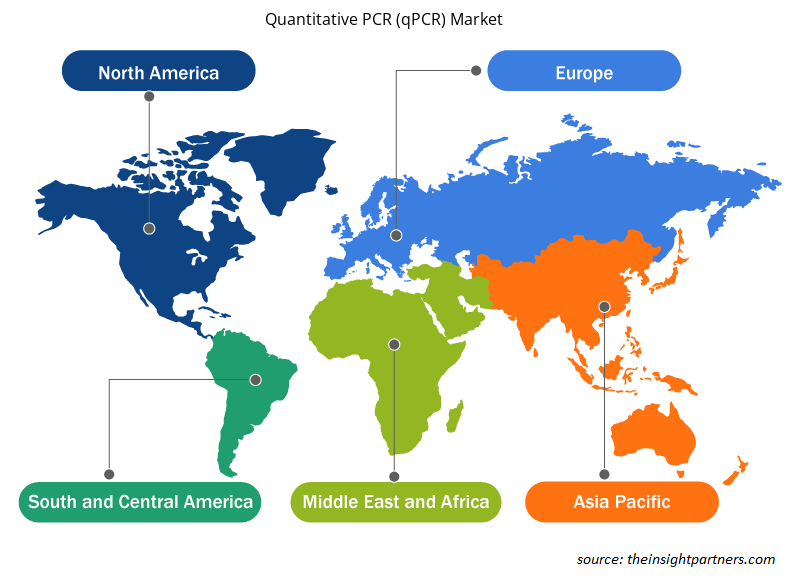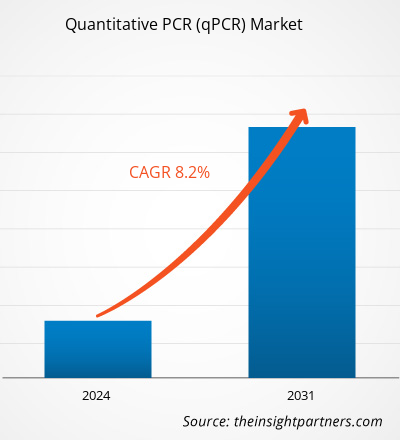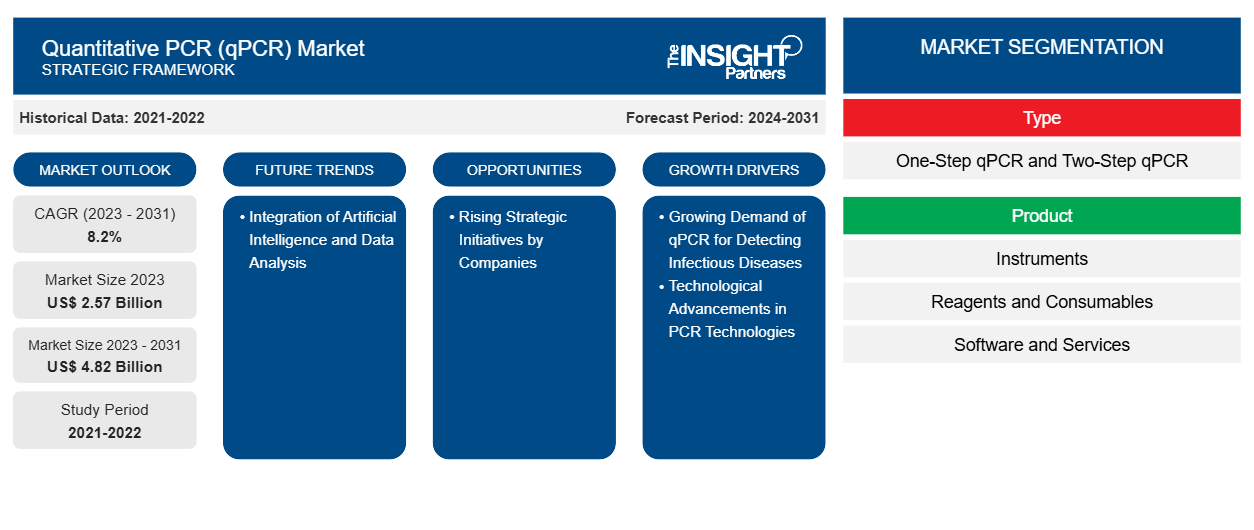Das Marktvolumen für quantitative PCR ( qPCR ) soll von 2,57 Milliarden US-Dollar im Jahr 2023 auf 4,82 Milliarden US-Dollar im Jahr 2031 anwachsen; für den Zeitraum 2023–2031 wird eine durchschnittliche jährliche Wachstumsrate (CAGR) von 8,2 % erwartet.
qPCR , auch bekannt als Echtzeit -PCR , ermöglicht es Benutzern, den Fortschritt einer PCR in Echtzeit zu überwachen. Durch den Einsatz von qPCR können Fachleute die PCR- Amplifikation gleichzeitig mit dem Fortschreiten der Reaktion berechnen. qPCR ist eine weit verbreitete Diagnosetechnik in verschiedenen Sektoren wie Forschung, Pharmazie und Biotechnologie. Die Nachfrage nach molekularen Tests wird durch technologische Fortschritte bei PCR- Systemen und den Bedarf an genauen und zuverlässigen Verfahren zur Erkennung von Krebs-Biomarkern angeheizt. Technologische Fortschritte bei qPCR- Technologien und die wachsende Nachfrage nach qPCR in der Diagnose von Infektionskrankheiten werden das Wachstum des Marktes in den kommenden Jahren voraussichtlich weiter vorantreiben. Zu den Markttrends für quantitative PCR ( qPCR ) gehört die Integration von künstlicher Intelligenz und Datenanalyse.
Wachstumstreiber:
Die PCR ist zu einem wichtigen Instrument für verschiedene klinische und diagnostische Anwendungen oder Untersuchungen geworden. Relative Einfachheit, hohe Sensibilität und Kosteneffizienz sind einige der bemerkenswerten Vorteile der PCR, die den Einsatz der PCR- Technologie in den letzten Jahren enorm gesteigert haben. Es handelt sich um eine robuste und zuverlässige Technologie, die in den meisten molekularbiologischen Laboren verwendet wird, um bestimmte DNA-Abschnitte für die Genotypisierung , das Klonen und die Analyse einzelner Nukleotidvariationen zu amplifizieren. Sie dient auch als Grundlage für die meisten Vorbereitungen für die Sequenzierung der nächsten Generation ( NGS ). Der technologische Fortschritt bringt verschiedene Arten von PCR- Techniken hervor. Insbesondere werden hochtechnologische Echtzeit- PCR- oder qPCR- Systeme verwendet, um Krankheiten zu diagnostizieren, Viren und Bakterien zu identifizieren und forensische Untersuchungen zu unterstützen. Seit seiner Entwicklung hat sich die qPCR zu einem wesentlichen Bestandteil der Molekularbiologie entwickelt und wird häufig in der Forschung, der klinischen Diagnostik und bei Tests zur Lebensmittelsicherheit eingesetzt. Seine Hauptvorteile liegen in den Möglichkeiten zur Quantifizierung und Genotypisierung von Virusstämmen , die es den Benutzern bietet, wodurch die Abschätzung einer Neuinfektion anhand der in den Zielgeweben vorhandenen Virusmenge möglich wird. Es hat den Bereich der Nukleinsäureerkennung und -quantifizierung revolutioniert und ermöglicht Forschern und Medizinern die Analyse von Genen, Mutationen und genetischen Varianten in beispiellosem Detailgrad.
CRISPR-basierte qPCR , automatisierte qPCR- Systeme, Multiplex -qPCR und qPCR der nächsten Generation sind Beispiele für die jüngsten Fortschritte in der qPCR- Technologie. Dank verbesserter Sensitivität, Spezifität und Genauigkeit erweitern diese Systeme die Anwendung von qPCR unter anderem in der klinischen Diagnostik, Forschung und Lebensmittelsicherheitsprüfung . Mithilfe von Multiplex -qPCR können mehrere Zielsequenzen in einer einzigen Reaktion erkannt und quantifiziert werden , was Zeit spart und den Probenbedarf reduziert. Diese Methode ist nützlich für die Erkennung von Krankheitserregern, die Erstellung von Genexpressionsprofilen und die Analyse genetischer Variationen. Darüber hinaus hilft qPCR der nächsten Generation dabei, Nukleinsäuresequenzen in einer Reihe von Proben mithilfe modernster Sequenzierungstechnologien zu erkennen und zu quantifizieren. Diese Technik verfügt über ein hohes Maß an Sensitivität und Genauigkeit beim Erkennen von Zielsequenzen mit geringer Häufigkeit. Bei sorgfältiger Berücksichtigung des Primerdesigns, der Optimierung und der Probenvorbereitung kann die qPCR- Analyse wertvolle Erkenntnisse über die Genexpression, Krankheitsdiagnose und Lebensmittelsicherheitsprüfungen liefern. Daher tragen technologische Fortschritte bei PCR- Technologien zum Marktwachstum der quantitativen PCR ( qPCR ) bei.
Passen Sie diesen Bericht Ihren Anforderungen an
Sie erhalten kostenlos individuelle Anpassungen an jedem Bericht, einschließlich Teilen dieses Berichts oder einer Analyse auf Länderebene, eines Excel-Datenpakets sowie tolle Angebote und Rabatte für Start-ups und Universitäten.
-
Holen Sie sich die wichtigsten Markttrends aus diesem Bericht.Dieses KOSTENLOSE Beispiel umfasst eine Datenanalyse von Markttrends bis hin zu Schätzungen und Prognosen.
Berichtssegmentierung und -umfang:
Die Marktanalyse für quantitative PCR ( qPCR ) wurde unter Berücksichtigung der folgenden Segmente durchgeführt: Typ, Produkt, Anwendung, Endbenutzer und Geografie. Basierend auf dem Typ ist der Markt in einstufige qPCR und zweistufige qPCR unterteilt . In Bezug auf das Produkt ist der Markt in Reagenzien und Verbrauchsmaterialien, Instrumente sowie Software und Dienstleistungen unterteilt. Nach Anwendung ist der Markt in Forschung, Klinik und Forensik segmentiert. Basierend auf dem Endbenutzer ist der Markt in Krankenhäuser und Diagnosezentren, Forschungslabore und akademische Institute, Pharma- und Biotechnologieunternehmen, forensische Labore und klinische Forschungsorganisationen kategorisiert. Der geografische Umfang des Marktberichts zur quantitativen PCR ( qPCR ) umfasst Nordamerika (USA, Kanada und Mexiko), Europa (Frankreich, Deutschland, Großbritannien, Spanien, Italien und das übrige Europa), den asiatisch-pazifischen Raum (China, Japan, Indien, Südkorea, Australien und den übrigen asiatisch-pazifischen Raum), den Nahen Osten und Afrika (Saudi-Arabien, Südafrika, Vereinigte Arabische Emirate und den übrigen Nahen Osten und Afrika) sowie Süd- und Mittelamerika (Brasilien, Argentinien und den übrigen Süd- und Mittelamerika).
Segmentanalyse:
Der Markt für quantitative PCR (qPCR) wird nach Typ in einstufige qPCR und zweistufige qPCR unterteilt. Das Segment der zweistufigen qPCR hatte im Jahr 2023 einen bedeutenden Marktanteil. Es wird erwartet, dass der Markt im Zeitraum 2023–2031 eine höhere CAGR verzeichnet.
Basierend auf dem Produkt wird der Markt in Reagenzien und Verbrauchsmaterialien, Instrumente sowie Software und Dienstleistungen unterteilt. Das Segment Reagenzien und Verbrauchsmaterialien hielt im Jahr 2023 einen bedeutenden Marktanteil bei der quantitativen PCR (qPCR) und wird voraussichtlich im Zeitraum 2023–2031 die höchste durchschnittliche jährliche Wachstumsrate verzeichnen.
Der Markt für quantitative PCR (qPCR) wird nach Anwendung in Forschung, Klinik und Forensik unterteilt. Das klinische Segment hatte im Jahr 2023 einen bedeutenden Marktanteil. Es wird erwartet, dass es zwischen 2023 und 2031 die höchste durchschnittliche jährliche Wachstumsrate auf dem Markt verzeichnet.
Basierend auf dem Endverbraucher ist der Markt für quantitative PCR (qPCR) in Krankenhäuser und Diagnosezentren, Pharma- und Biotechnologieunternehmen, Forschungslabore und akademische Institute, forensische Labore und klinische Forschungsorganisationen unterteilt. Das Segment Krankenhäuser und Diagnosezentren hatte im Jahr 2023 einen bedeutenden Marktanteil und wird voraussichtlich im Zeitraum 2023–2031 die höchste durchschnittliche jährliche Wachstumsrate verzeichnen.
Regionale Analyse:
Geografisch ist der Markt für quantitative PCR (qPCR) in Nordamerika, Europa, Asien-Pazifik, Süd- und Mittelamerika sowie den Nahen Osten und Afrika unterteilt. Im Jahr 2023 eroberte Nordamerika einen bedeutenden Marktanteil. Im Jahr 2023 dominierten die USA den Markt in dieser Region. Das Wachstum des Marktes für quantitative PCR (qPCR) in Nordamerika ist auf die umfangreiche Forschung und Entwicklung in verschiedenen akademischen und Forschungsinstituten, den zunehmenden Fokus auf den Einsatz fortschrittlicher Techniken und Werkzeuge im Gesundheitswesen, staatliche und private Initiativen und Fonds zur Förderung der Präzisionsmedizin sowie der Genomforschung, die steigende Nachfrage nach innovativen Produkten von PCR-Unternehmen und die Präsenz wichtiger Marktteilnehmer zurückzuführen.
Im Juni 2020 brachte Azure Biosystems das Echtzeit-PCR-Gerät Azure Cielo auf den Markt. Cielo ist ein 96-Well-qPCR-Gerät, das das Markenversprechen von kompaktem Design, hoher Leistung und intuitivem Workflow einhält. Die Empfindlichkeit und Zuverlässigkeit des Azure Biosystems wurden für Genomikanwendungen eingesetzt. Cielo ist das erste Instrument des Unternehmens, das speziell für den Genomik-Workflow entwickelt wurde.
Branchenentwicklungen und zukünftige Chancen:
Der Marktbericht zur quantitativen PCR (qPCR) umfasst die Positionierung und Konzentration des Unternehmens, um die Leistung der Wettbewerber auf dem Markt zu bewerten. Gemäß den Pressemitteilungen des Unternehmens sind im Folgenden einige Initiativen der wichtigsten Akteure auf dem Markt aufgeführt:
- Im Mai 2023 führte Standard BioTools Inc. die NGS-Bibliotheksvorbereitungsfunktion auf dem X9 High-Throughput Genomics System ein. Mit dieser Einführung können Kunden Echtzeit-PCR- und NGS-Bibliotheksvorbereitungsanwendungen auf einem einzigen Tischsystem ausführen, um die Entdeckung durch Screening zu unterstützen.
- Im März 2021 stellte Agilent Technologies Inc. ein auf Echtzeit-Reverse-Transkription (qRT)-PCR basierendes Diagnosekit zum Nachweis von SARS-CoV-2-RNA vor. Das Agilent SARS-CoV-2 qRT-PCR Dx-Kit ist ein In-vitro-Diagnostikreagenzienkit zum Nachweis von SARS-CoV-2-RNA mittels qRT-PCR. Der Einzelröhrchentest ermöglicht eine höhere Effizienz, einen höheren Durchsatz, weniger Verbrauchsmaterial und eindeutige Ergebnisse für die Zuverlässigkeit der Testergebnisse.
Regionale Einblicke in den Markt für quantitative PCR (qPCR)
Die regionalen Trends und Faktoren, die den Markt für quantitative PCR (qPCR) während des gesamten Prognosezeitraums beeinflussen, wurden von den Analysten von Insight Partners ausführlich erläutert. In diesem Abschnitt werden auch die Marktsegmente und die Geografie für quantitative PCR (qPCR) in Nordamerika, Europa, im asiatisch-pazifischen Raum, im Nahen Osten und Afrika sowie in Süd- und Mittelamerika erörtert.

- Erhalten Sie regionale Daten zum Markt für quantitative PCR (qPCR)
Umfang des Marktberichts zur quantitativen PCR (qPCR)
| Berichtsattribut | Details |
|---|---|
| Marktgröße im Jahr 2023 | 2,57 Milliarden US-Dollar |
| Marktgröße bis 2031 | 4,82 Milliarden US-Dollar |
| Globale CAGR (2023 - 2031) | 8,2 % |
| Historische Daten | 2021-2022 |
| Prognosezeitraum | 2024–2031 |
| Abgedeckte Segmente |
Nach Typ
|
| Abgedeckte Regionen und Länder |
Nordamerika
|
| Marktführer und wichtige Unternehmensprofile |
|
Dichte der Marktteilnehmer für quantitative PCR (qPCR): Auswirkungen auf die Geschäftsdynamik verstehen
Der Markt für quantitative PCR (qPCR) wächst rasant, angetrieben durch die steigende Nachfrage der Endnutzer aufgrund von Faktoren wie sich entwickelnden Verbraucherpräferenzen, technologischen Fortschritten und einem größeren Bewusstsein für die Vorteile des Produkts. Mit steigender Nachfrage erweitern Unternehmen ihr Angebot, entwickeln Innovationen, um die Bedürfnisse der Verbraucher zu erfüllen, und nutzen neue Trends, was das Marktwachstum weiter ankurbelt.
Die Marktteilnehmerdichte bezieht sich auf die Verteilung der Firmen oder Unternehmen, die in einem bestimmten Markt oder einer bestimmten Branche tätig sind. Sie gibt an, wie viele Wettbewerber (Marktteilnehmer) in einem bestimmten Marktraum im Verhältnis zu seiner Größe oder seinem gesamten Marktwert präsent sind.
Die wichtigsten Unternehmen auf dem Markt für quantitative PCR (qPCR) sind:
- Abbott Laboratories
- Thermo Fisher Scientific Inc.
- Standard Biotools Inc.
- F. Hoffmann-la Roche Ltd
- Qiagen
- Lepu Medizintechnik Beijing Co Ltd
Haftungsausschluss : Die oben aufgeführten Unternehmen sind nicht in einer bestimmten Reihenfolge aufgeführt.

- Überblick über die wichtigsten Akteure auf dem Markt für quantitative PCR (qPCR)
Wettbewerbslandschaft und Schlüsselunternehmen:
Die Marktprognose für quantitative PCR (qPCR) kann Stakeholdern bei der Planung ihrer Wachstumsstrategien helfen. Abbott Laboratories, Thermo Fisher Scientific Inc., Standard Biotools Inc., F. Hoffmann-la Roche Ltd, Qiagen, Lepu Medical Technology Beijing Co Ltd, Bio-rad Laboratories Inc., Takara Bio Inc., Agilent Technologies Inc. und Fujirebio gehören zu den führenden Akteuren auf dem Markt. Diese Unternehmen konzentrieren sich auf die Einführung neuer Hightech-Produkte, die Weiterentwicklung bestehender Produkte und die geografische Expansion, um der wachsenden Verbrauchernachfrage weltweit gerecht zu werden.
- Historische Analyse (2 Jahre), Basisjahr, Prognose (7 Jahre) mit CAGR
- PEST- und SWOT-Analyse
- Marktgröße Wert/Volumen – Global, Regional, Land
- Branchen- und Wettbewerbslandschaft
- Excel-Datensatz
Aktuelle Berichte
Erfahrungsberichte
Grund zum Kauf
- Fundierte Entscheidungsfindung
- Marktdynamik verstehen
- Wettbewerbsanalyse
- Kundeneinblicke
- Marktprognosen
- Risikominimierung
- Strategische Planung
- Investitionsbegründung
- Identifizierung neuer Märkte
- Verbesserung von Marketingstrategien
- Steigerung der Betriebseffizienz
- Anpassung an regulatorische Trends























 Kostenlose Probe anfordern für - Markt für quantitative PCR (qPCR)
Kostenlose Probe anfordern für - Markt für quantitative PCR (qPCR)